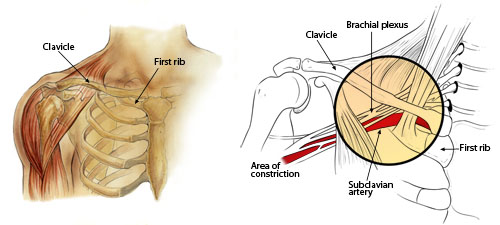Thoracic Outlet Syndrome
Description
The thoracic outlet is the space between your collarbone (clavicle) and your first rib. This narrow passageway is crowded with blood vessels, muscles, and nerves. If the shoulder muscles in your chest are not strong enough to hold the collarbone in place, it can slip down and forward, putting pressure on the nerves and blood vessels that lie under it. This causes a variety of symptoms which together are known as thoracic outlet syndrome.
Cause
Thoracic outlet syndrome can result from injury, disease, or a congenital problem, such as an abnormal first rib. It is more common in women than in men, and poor posture and obesity can aggravate the condition.
Psychological changes are often seen in patients with thoracic outlet syndrome. It is not clear whether these changes are a cause or result of the syndrome.
Symptoms
 Symptoms may vary, depending on which nerves or blood vessels are compressed. Symptoms from nerve compression are much more common than symptoms from blood vessel compression.
Symptoms may vary, depending on which nerves or blood vessels are compressed. Symptoms from nerve compression are much more common than symptoms from blood vessel compression.
> Pressure on the nerves (brachial plexus) may cause a vague, aching pain in the neck, shoulder, arm, or hand. It may also cause pain, numbness, or tingling on the inside of the forearm and the fourth and fifth fingers of the hand. Weakness may make your hand clumsy.
> Pressure on the blood vessels can reduce the flow of blood out of your arm, resulting in swelling and redness of your arm. Less commonly, pressure can reduce the blood flow into your arm and hand, making them feel cool and easily fatigued.
> Overhead activities are particularly difficult because they worsen both types of compression.
> There may be a depression in your shoulder, or swelling or discoloration in your arm.
> Your range of motion may be limited.
Doctor’s Examination
Diagnosis of this condition can be more complicated than diagnosis of some other more common shoulder conditions because there may be many symptoms to explain. Your doctor’s evaluation will include an extensive medical history, physical examination, and diagnostic testing.
Medical History and Physical Examination
Your doctor will ask you about the history of your symptoms, perform a thorough physical examination, and try to reproduce your symptoms by examining your arm and hand in several positions.
Tests
A test doctors often use to help them identify thoracic outlet syndrome is the elevated arm stress test. Your doctor will have you raise your arms over your head, then open and close your fists for approximately 3 minutes. If this reproduces your symptoms, it is likely that you have thoracic outlet syndrome.
To better see and evaluate the bones, muscles, tendons, and blood vessels, your doctor may order imaging tests. These may include x-rays, computed tomography (CT) scans, magnetic resonance imaging (MRI) scans, and ultrasound.
In addition, your doctor may order special blood circulation tests and nerve conduction tests to help make the diagnosis.
Treatment
Treatment for thoracic outlet syndrome usually does not include surgery.
Nonsurgical Treatment
Physical therapy. Exercises can help strengthen the muscles surrounding the shoulder so that they are better able to support the collarbone. Postural exercises can help you stand and sit straighter, which lessens the pressure on the nerves and blood vessels.
Nonsteroidal anti-inflammatory medications. Drugs like naproxen and ibuprofen can ease the pain and reduce swelling.
Weight loss. If you are overweight, your doctor may recommend that you begin a weight loss program. Being overweight can stress the shoulder muscles that support your collarbone.
Lifestyle changes. You may need to change your workstation layout, avoid strenuous activities, and even modify everyday activities that aggravate your symptoms.
Surgical Treatment
If nonsurgical treatment does not relieve your symptoms, your doctor may recommend surgery.
Surgery for thoracic outlet syndrome may involve removing a portion of an abnormal first rib, releasing a muscle that joins the neck and chest, or sometimes both.
Prevention
If you have symptoms of thoracic outlet syndrome, avoid carrying heavy bags over your shoulder because this depresses the collarbone and increases pressure on the important structures in the thoracic outlet.
You should also do some simple exercises to keep your shoulder muscles strong. Here are four that you can try—10 repetitions of each exercise should be done twice daily:
Corner Stretch – Stand in a corner (about 1 foot from the corner) with your hands at shoulder height, one on each wall. Lean into the corner until you feel a gentle stretch across your chest. Hold for 5 seconds.
Neck Stretch – Put your left hand on your head, and your right hand behind your back. Pull your head toward your left shoulder until you feel a gentle stretch on the right side of your neck. Hold for 5 seconds. Switch hand positions and repeat the exercise in the opposite direction.
Shoulder Rolls – Shrug your shoulders up, back, and then down in a circular motion.
Neck Retraction – Pull your head straight back, keeping your jaw level. Hold for 5 seconds.
As with all exercise programs, if any of these movements cause pain, stop immediately.
Shoulder information provided by Dr. Darren Keiser MD
Article URL: http://orthoinfo.aaos.org/topic.cfm?topic=A00336&webid=2FDDE053
